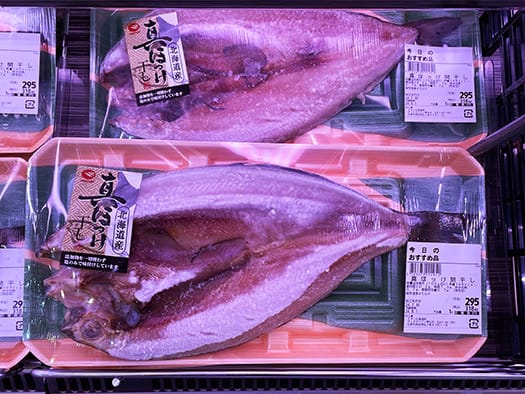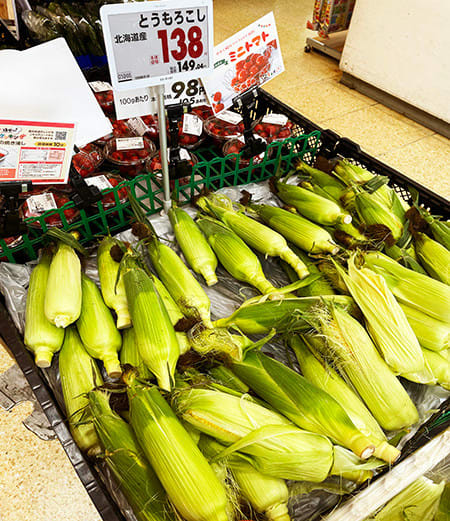

どうも「ホッケの開き」の縁が続いております(笑)。わたしは北海道民として、札幌市民としてごく普通にスーパーなどで「あ、ホッケの開きだ。いいな、そのうち食べよ」と無意識に買いものカゴに入れていたのです。ホッケには「シマ(縞)ホッケ」といわゆる「ホッケ」2種類あってということはあんまり強く意識していなかった。で、シマホッケはアタマを落としているんだ、としかその形態でしか違いを意識はしていなかった。
きのうのブログ反響ではいつもコメントをいただける道内の住宅研究者の方からまで、「ホッケの開き、盛り上がっていますね(笑)」としてコメントをいただいた。どうも世間をお騒がせしているようで、住宅ネタがメインのブログとしては、本筋外の話題で恐縮しております。
シマホッケはだいたい「ロシア産」と書いてあるので、とくにロシアによるウクライナ侵攻があって以降は拒否的だった。一方でいわゆる「ホッケ」は上の写真のようにアタマが正直に付いていて、シマホッケに比べたら、やや身の厚みが薄いかなとは思っていても、こっちを愛好していた。
きのうもふと立ち寄ったスーパーでどうしても目が行って、また写真を取っていた(笑)。きのうのスーパーではホッケ1尾295円の値付け。その下にきのうのブログで使った錦糸町「シマホッケ」の写真を上げましたので両者の違いはお分かりいただけるでしょう。いつも馴染みのスーパーでは、このホッケは398円くらいなので、かなり割安感はあった。シマホッケだとロシア産で1尾298円が相場だったので、それと比較しても割安感がある。なんですが、わたしは案外保守的なのでいつものスーパーでも再度確認してから、判断したいと思います(笑)。
ということで庶民の味ですが、国際関係・戦争の影もそこに投影されて食べものの相場観にも変化が生まれてくるのでしょう。今後ともウォッチし続けて行きたいと思います。

さて北海道の夏の味覚と言えばなんといってもトウモロコシ。これも「トウキビ」という別称もある。わたし的にはトウキビ一択なのですが、これは日本各地域での言い方の違いなのでしょう。
日本人の品種改良努力はすさまじいものがあって、最近の進化した品種では、ちょっと味覚で驚かされるものがある。こういう品種改良への志向性の根源には、北海道の開拓・国土利用というDNAがそこに投影されているように思う。コメが採れない土地から採れる土地への進化努力を日本民族は北海道で行ってきた。明治以前にはほとんど採れなかったコメが、いまでは新潟県に肉薄するコメ産地に変貌した。そこではコツコツとした民族的努力が傾注され続けてきた。いまでは品質面でも上位等級のコメが産出されブランド米までが出現している。
トウキビでもいま、同様の進化努力が花開きつつあるのでしょう。すばらしい。
English version⬇
Hokkaido's common taste, “hokke no kirai” (hokke fish crackers) once again.
I was completely excited about hokke. International relations are also projected onto the world of taste, and we are getting deeper and deeper into the world of taste. On the other hand, sugarcane is at its peak. The evolution of umami is amazing. The evolution of umami is amazing.
Thanks for your continued interest in “hokke no akira” (open hokke) (laughs). As a Hokkaido-native and a citizen of Sapporo, I would usually go to the supermarket and say to myself, “Ah, hokke (hokke) open fish. I'll have some one of these in the future. I was not really aware that there are two types of hokke: striped hokke and so-called hokke. I was only aware that striped hokke had their heads cut off, and that was the only difference between the two.
Yesterday, I even received a comment from a housing researcher in Hokkaido, who always comments on my blog, saying, “The hokke are getting excited about opening hokke (laughs). It seems to be causing a stir in the world, and as a blog whose main topic is housing, I am sorry to say that it is a topic outside of our main focus.
Since striped hokke is usually labeled as “Russian,” I have been rejecting it, especially after Russia's invasion of Ukraine. On the other hand, the so-called “hokke” has its head honestly attached as shown in the photo above, and even though I thought its meat was a little less thick than that of striped hokke, I was a fan of this type of hokke.
Yesterday, too, I couldn't help but notice it at the supermarket where I stopped by and took another picture of it (laugh). At the supermarket yesterday, a hokke was priced at 295 yen. Below I have uploaded a photo of the Kinshicho “striped hokke” I used in yesterday's blog so you can see the difference between the two. At the supermarket I am familiar with, this hokke is priced at about 398 yen, so I felt it was quite inexpensive. The price of Russian striped hokke was 298 yen per piece, so it seemed cheap compared to that. But I am a conservative person, so I will make a decision after checking again at my usual supermarket (laugh).
So, although it is the taste of the common people, the shadow of international relations and wars will be projected on it, and the market price of food will probably change as well. I would like to continue to watch the market.
The summer delicacy of Hokkaido is corn. It is also known by another name, “sugarcane. For me, corn is the only one I would choose, but this is probably due to differences in the terminology used in different regions of Japan.
The Japanese have made tremendous efforts in breeding, and some of the more recently developed varieties are a bit surprising to the palate. I believe that Hokkaido's DNA of cultivation and utilization of the land is projected at the root of this orientation toward variety improvement. The Japanese people have made efforts in Hokkaido to evolve from a land where rice could not be harvested to a land where rice could be harvested. Rice, which was almost unobtainable before the Meiji era, has transformed itself into a rice-producing region that is now close to Niigata Prefecture. The Japanese people's persistent efforts have been devoted to the development of the rice production area. Nowadays, the quality of the rice is of a higher grade, and even brand-name rice is being produced.
The same evolutionary efforts are now blossoming in the sugarcane industry. This is wonderful.









